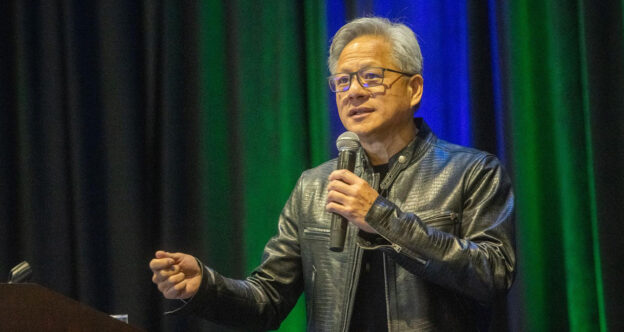Nvidia CEO Jensen Huang said Wednesday (Feb. 26) that sales of the company’s most advanced chip architecture hit a record in the fourth quarter, and it is a harbinger of even more demand ahead because the artificial intelligence (AI) era has just begun.
“AI is advancing at light speed,” Huang said in a conference call with Wall Street analysts to discuss earnings. “We’re just at the start of the age of AI.”
The architecture for the Blackwell GPU, which was delayed for two months due to technical issues, booked $11 billion in revenue just in one quarter, with large cloud companies leading the sales. Data center revenues more than doubled, driven by demand for Blackwell and its H200 chip series.
Heading into Nvidia’s earnings, investors were concerned that the low-cost, high-performing AI models developed by Chinese AI startup DeepSeek would lead to weaker Nvidia chip demand. DeepSeek’s V3 model only cost $5.6 million to train using 2,000 slower H800 Nvidia chips. In contrast, OpenAI’s GPT-4 cost $100 million to train on 25,000 H100 Nvidia GPUs.
But Huang said that on the contrary, DeepSeek open-sourced its high-performing reasoning model, which put it in the hands of many startups and other users. This expands the market for AI workloads, and by extension, GPUs.
Added Brian Colello, Morningstar analyst, in a recent research note: Despite DeepSeek’s offering a less expensive solution, “AI GPU demand still exceeds supply, so while slimmer models may enable greater development for the same number of chips, we still think tech firms will continue to buy all the GPUs they can as part of this AI ‘gold rush.’”
From Consumer AI to Business AI
Huang said the world is just two years into the current wave of AI advancements, starting with generative AI, which powered consumer use of AI, and now moving into AI agents, which will power business use of AI. Following these two trends, he sees the next stage is physical AI like robots.
“AI has gone mainstream” and one day it will be embedded in all industries, Huang believes.
Meanwhile, AI is already ushering in a new wave in software development. In the past, software ran on CPUs, but in the age of AI, software would run on machine learning, Huang said. “This is the future of software,” he said.
Further, data centers will become “AI factories,” since they will be processing AI workloads that will power most industries in the world, Huang believes.
“We have a fairly good line of sight of the amount of capital investment that data centers are building out towards,” Huang said. “We know that going forward, the vast majority of software is going to be based on machine learning, and so accelerated computing and generative AI and reasoning AI are going to be the type of architecture you’d want in your data center.”
Asked about headwinds from U.S. export controls of its most advanced chips to China, the company’s second-largest market, Nvidia officials said sales of its chips to China are about half from what they were before export restrictions. But as a percentage of revenue, it has remained the same.
In 2022, the Biden administration banned sales of certain chips to China due to national security concerns. Under the Trump administration, however, the concern is about possible tariffs on chips that would affect its business.
Nvidia said the impact is unknown and will depend on the timing, countries affected and the size of the tariffs.
Nvidia Earnings Beat Consensus
The chipmaker, which just ended its fiscal year 2025, reported net income of $22.1 billion, or 89 cents per share, for the fourth quarter. Revenue came in at $39.3 billion. The quarter beat Wall Street analysts’ consensus earnings of 85 cents per share and $38.16 billion in revenue.
Year over year, quarterly net income was up 80% and revenue rose by 78%.
For the year, Nvidia reported net income of $72.9 billion, up 145% from a year ago, on revenue of $130.5 billion, up 114% from the prior year. Earnings per share came to $2.94 for the year, which is a penny shy of consensus. But Nvidia beat on the topline; analysts expected $129.28 billion.
For the first quarter of fiscal 2026, Nvidia expects to record revenue of $43 billion, plus or minus 2%. Analysts are expecting revenue of $42.05 billion.
Shares of Nvidia were about flat up in after-hours trading. The company’s market cap was $3.22 trillion as of market close on Wednesday (Feb. 26), second only to Apple as the most valuable in the world.
Nvidia Revenue Spikes as Agentic AI Aims to Transform Businesses





